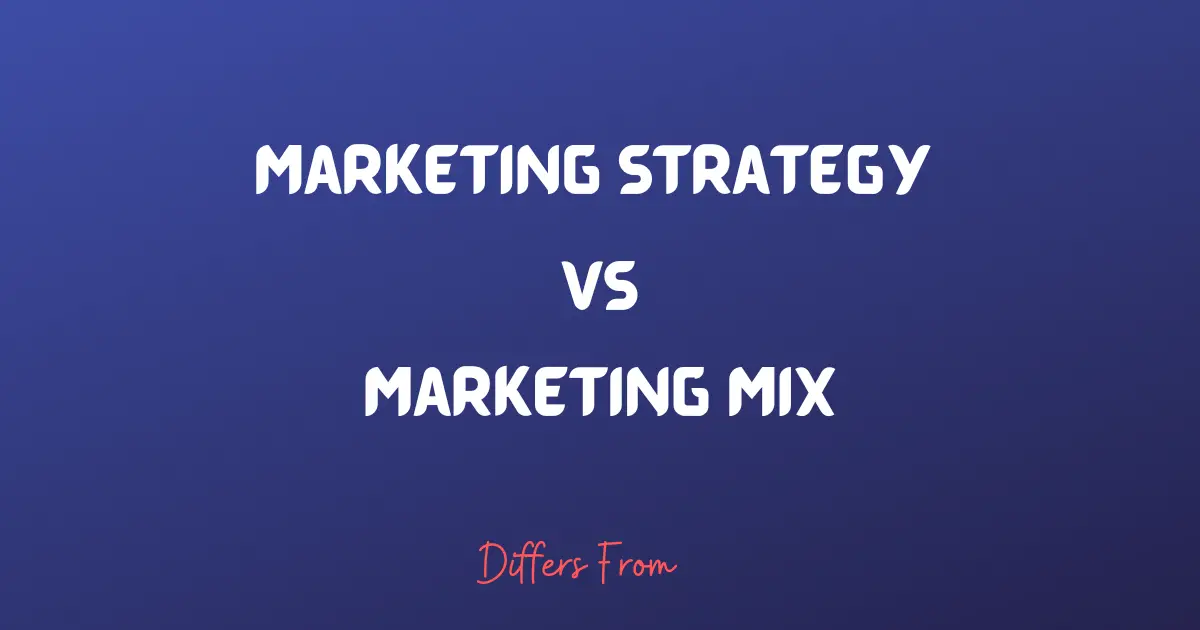Embarking on a journey into the realm of marketing often brings us face-to-face with terms like ‘marketing strategy’ and ‘marketing mix.’
While they may sound similar, these concepts play distinct roles in shaping the success of a business.
In this exploration, we unravel the nuances that set apart a marketing strategy from a marketing mix, shedding light on their unique contributions to the intricate world of marketing.
Let’s Go!
Difference between marketing strategy and marketing mix
| Marketing Strategy | Marketing Mix | |
| Focus | Strategy focuses on overall goals and direction | Mix focuses on specific tactics to achieve those goals. |
| Scope | Strategy is broad and high-level. | The mix is detailed and operational. |
| Timeframe | Strategy is a long-term plan. | Mix involves short-term actions. |
| Components | The strategy includes target market, positioning, and resources. | Mix comprises 4Ps or 7Ps. |
| Purpose | Strategy provides a roadmap for achieving business objectives. | Mix implements the strategy through specific actions. |
| Decision Level | Strategy is a top-level decision. | Mix involves operational and tactical decisions. |
| Flexibility | Strategy is less flexible and changes infrequently. | Mix is more adaptable to short-term market dynamics. |
| Communication | The mix is more adaptable to short-term market dynamics. | Mix communicates specific product/service details. |
| Implementation | Strategy guides overall business decisions. | Mix implements day-to-day marketing activities. |
| Measurement | Strategy success is measured by achieving long-term objectives. | Mix success is measured by the effectiveness of tactical elements in the short term. |
What is a marketing strategy?
A marketing strategy is a comprehensive plan that outlines how a business will achieve its marketing goals and objectives.
It involves analyzing market trends, identifying target audiences, positioning products or services, and determining the best ways to reach and influence customers.
A successful marketing strategy requires a deep understanding of customer needs, competitors, and market dynamics, and it should guide all marketing activities to ensure consistent and effective messaging that drives desired outcomes.
What is the marketing mix?
The marketing mix refers to the set of tactical elements that businesses use to promote their products or services effectively.
These elements, often referred to as the “4 Ps,” include product (features, design, packaging), price (pricing strategies), promotion (advertising, sales promotion), and place (distribution channels).
The marketing mix requires careful consideration and balancing to create a compelling offering that meets customer needs while maximizing business outcomes.
Comparison between marketing strategy and marketing mix
Marketing Strategy and Marketing Mix are two crucial elements in the field of marketing, but they serve different purposes and functions. Let’s delve into each of them and explore their characteristics and differences.
Marketing Strategy
Marketing strategy refers to the overall plan developed by a company to achieve its marketing objectives and gain a competitive advantage in the market.
It involves identifying target markets, understanding customer needs and preferences, and positioning the brand or product effectively.
A marketing strategy outlines the long-term direction and vision for marketing activities and guides the allocation of resources.
Key features of a marketing strategy
- Market Segmentation: Identifying specific groups of customers with similar characteristics and needs.
- Targeting: Selecting the most attractive customer segments to focus on and pursue.
- Positioning: Developing a unique and compelling brand image in the minds of consumers.
- Differentiation: Creating a competitive advantage by offering unique value or features.
- Competitive Analysis: Assessing the strengths and weaknesses of competitors.
Marketing Mix
The marketing mix, also known as the “4Ps,” is a tactical framework that outlines the controllable elements a company can use to influence customer purchasing decisions.
It involves product, price, place, and promotion—four essential components that businesses use to create a comprehensive marketing plan.
Key features of the marketing mix
- Product: Refers to the tangible goods or intangible services offered by a company. It includes features, design, quality, packaging, and branding.
- Price: Determines the amount customers are willing to pay for a product or service. Pricing strategies involve setting the right price to achieve profitability while considering market demand, competition, and perceived value.
- Place: Involves making the product or service available to customers through distribution channels, including physical stores, online platforms, and intermediaries.
- Promotion: Encompasses various activities aimed at communicating and promoting the product to the target market. It includes advertising, sales promotions, public relations, and personal selling.
Conclusion
Marketing strategy is a long-term plan that guides overall marketing efforts, focusing on target markets, positioning, and competitive analysis.
The marketing mix, on the other hand, consists of tactical elements (product, price, place, promotion) used to influence customer decisions. The strategy provides direction, while the mix executes specific actions.
FAQs
What is the main focus of a marketing strategy compared to the marketing mix?
Marketing strategy focuses on long-term planning, setting goals, identifying target markets, and positioning the brand, while the marketing mix focuses on the tactical elements of product, price, place, and promotion.
How does a marketing strategy differ from the marketing mix in terms of timeframe?
A marketing strategy is a long-term plan that guides overall marketing efforts, while the marketing mix is more short-term and operational, addressing specific elements within the strategy.
Which one provides a broader perspective on marketing activities: marketing strategy or marketing mix?
Marketing strategy provides a broader perspective by encompassing market analysis, competitive positioning, target market selection, and overall direction, while the marketing mix focuses on specific actions within the strategy.
What is the role of marketing strategy and marketing mix in resource allocation?
Marketing strategy guides resource allocation by identifying the most promising target markets and allocating resources accordingly.
The marketing mix helps allocate resources to specific tactics within each element (product, price, place, promotion) to achieve strategic goals.
How do marketing strategy and marketing mix contribute to a company’s competitive advantage?
Marketing strategy helps identify and leverage competitive advantages by positioning the brand uniquely and targeting specific customer segments effectively.
The marketing mix enables companies to create and deliver a compelling product, price it competitively, make it accessible, and promote it effectively to gain an edge in the market.

